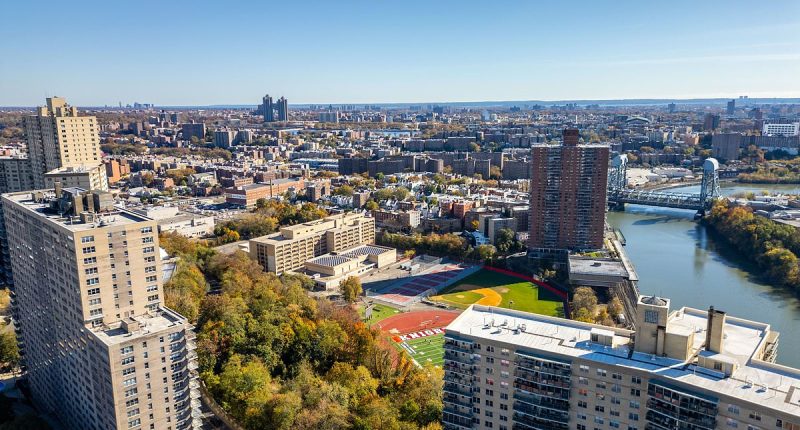Share this @internewscast.com
It’s the birthplace of hip-hop, rap and Yankees baseball.
Lush gardens and parks dot the neighborhood of 1.4million, with authentic Puerto Rican, Italian and Mexican restaurants on every corner.
It’s also America’s Alzheimer’s capital.
The Bronx has the highest rate of Alzheimer’s disease in the nation, tied with Baltimore and Miami.
One in six adults over 65 in the New York City borough are diagnosed with Alzheimer’s, compared to around one in 10 nationally.
Researchers believe the Bronx became an Alzheimer’s hotspot due to its long history of poverty rates well above the national average and a large minority population that has historically been more likely to be struck by the disease.
The area also has New York City’s highest rate of food insecurity, leading residents to turn to ultraprocessed foods shown to induce harmful inflammation in the brain.
Healthcare providers in the Bronx have now launched a four-week pilot program to emulate Ikaria, Greece, a small island in the Aegean Sea.

The Bronx, pictured here, has the highest Alzheimer’s rate in the country, tied with Baltimore and Miami
The island of 8,300 is one of the world’s five Blue Zones, areas where residents regularly live well into their 80s, 90s and even 100.
One of three Ikarians, for example, live past age 90.
One man named Stamatis Moraitis, who was born on Ikaria but moved to the US for work, was given a death sentence lung cancer diagnosis in 1976 and just nine months to live. After moving back home to Ikaria, he survived another 45 years until age 98.
Residents of the Bronx, in comparison, tend to live to 81, still more than the national average but the lowest out of all five New York City boroughs.
The Bronx program, dubbed the ‘Blue Zones Challenge,’ has recruited 100 Bronx residents of varying ages, races and backgrounds to follow in the footsteps of Ikarians.
The only enrollment requirement was living in the Bronx, and participants were encouraged to eat more foods aligned with the Mediterranean diet like salmon and arugula. They then were tasked with journaling their habits for four weeks.
The experts running the program told DailyMail.com the goal isn’t to completely reverse the risk of Alzheimer’s in just a month.
Instead, they hope it will help residents adopt long-term healthy habits shown to combat the disease.
Dr Edward Cisek, chief research, grants and evaluation officer at CaringKind, one of the two organizations in charge of the Blue Zones Challenge, told this website: ‘It’s not expected huge changes are going to happen in four weeks. It’s to set residents up for success.’
The program will run through May 27, 2025, and the team will unveil the findings next month.
The team is looking to find if the majority of the 100 participants are able to experience notable changes like losing weight, having more energy or improvements in chronic conditions like diabetes.
They hope the program may inspire larger initiatives reaching the rest of New York City.
Nearly 7million Americans over age 65 have Alzheimer’s disease, the most common form of dementia.
According to the Alzheimer’s Association, New York state has the third-highest percentage of over-65s with Alzheimer’s disease at nearly 13 percent, trailing only behind Washington DC and Maryland.
This adds up to roughly 427,000.

‘Blue Zones’ are places lauded as longevity hotspots with low rates of chronic diseases and significant amounts of people living well into their 90s and beyond
In the Bronx, 17 percent of adults over 65 – about 35,700 – have been diagnosed with Alzheimer’s.
The national rate is 11 percent.
In a 2023 report, Alzheimer’s Association researchers said the higher rates could be due to the demographics in the Bronx.
The latest Census data shows 57 percent of residents are Hispanic and 28 percent are Black, more than any other New York county.
Both of these groups have the highest rates of Alzheimer’s disease nationally. The Alzheimer’s Association reports Black Americans over 65 are more than twice as likely as their white peers to be struck by the condition, and Hispanics are 1.5 times more likely.
Recent research shows this could be due to Black and Hispanic populations having higher rates of cardiovascular conditions that affect the blood vessels.
Heart disease can damage blood vessels and reduce the amount of blood that flows to the brain. Over time, this kills off brain tissues and cells, leading to dementia, particularly vascular dementia.
Diabetes, which is twice as common in Black adults, also weakens blood vessels in the brain and leads to inflammation.
Socioeconomic status may also be a factor in the Bronx’s wave of Alzheimer’s disease.
The Bronx is one of America’s most impoverished urban counties and the poorest in New York state, with 28 percent of residents living below the poverty line. Nationwide, 11 percent of Americans live in poverty.
The median household income in the Bronx in 2022 was $47,260, about 41 percent less than $80,610 nationally.

The researchers behind the Blue Zones Challenge in the Bronx are aiming to emulate the habits of Ikaria, Greece (pictured here), where rates of dementia are significantly lower
These factors are more likely to lead residents to turn toward cheap, ultraprocessed foods loaded with saturated fats, sugars and artificial additives.
These foods have been shown to increase inflammation and oxidative stress, an imbalance between disease-fighting antioxidants and harmful free radicals.
Free radicals attack cell DNA and promote the growth of toxic amyloid-beta and tau proteins shown to cause Alzheimer’s.
In Ikaria, meanwhile, residents over age 85 have a one in 10 chance of developing Alzheimer’s disease. That’s the same risk for Americans 20 years younger.
By the time the average US adult reaches 85, they are three times more likely to develop the disease than an 85-year-old in Ikaria.
Ikaria also has about half America’s rate of heart disease.
This is largely because Ikarians traditionally follow the Mediterranean diet, which has been hailed as the healthiest eating plan in the world.
The diet emphasizes vegetables, dark leafy greens, olive oil, avocadoes, whole grains and nuts and seeds. These foods are rich in nutrients like omega-3 fatty acids, which have been shown to reduce levels of harmful inflammation and protect neurons from damage.
Research in the Journal of Alzheimer’s Disease also suggested omega-3s reduce levels of amyloid-beta and tau proteins.
Ikaria’s long life expectancy may also be due to most people living a more relaxed lifestyle.
To shift the Bronx’s health closer toward Ikaria, the Blue Zones Challenge emphasizes lifestyle changes like choosing foods more closely aligned with the Mediterranean diet.
Eleonora Tornatore-Mikesh, president and CEO of CaringKind, points toward a 2024 Lancet study that round addressing 14 lifestyle factors lowered the risk of dementia by about 40 percent. These included addressing diet, obesity, diabetes and physical inactivity.

Dr Anderson Torres, who is helping run the Blue Zones Challenge, is also participating in the program. He said he has lost weight and has had fewer blood sugar spikes related to his type 2 diabetes
She told DailyMail.com that while certain factors like genetic predisposition can’t easily be reversed, the Blue Zones Challenge focuses on factors that are within the average person’s grasp.
She said: ‘This is the portion you can control: lifestyle. We can’t fix all things, but we know lifestyle changes can impact good healthcare.’
The only requirement to sign up for the challenge was being a resident from the Bronx.
Dr Anderson Torres, CEO of Bronx-based elderly care organization RAIN Total Care who is also a participant in the challenge, told DailyMail.com because Alzheimer’s is so prevalent in the area that the team didn’t need to specifically seek out a particular group of people for this initial study.
‘By being from the Bronx, we are all at risk,’ he said.
The 100 participants enrolled in the study were told to download a journaling app and keep track of everything they ate, as well as habits like exercising.
They weren’t given specific instructions but were instead told to be more intentional with their habits. For example, instead of choosing fried chicken, opt for grilled. Participants are also encouraged to add more dark, leafy greens and healthy fats to their meals and suggest their peers try the same.
‘These lifestyle changes work best when you do them with other people,’ Dr Cisek said.
Tornatore-Mikesh told this website the team chose four weeks because research suggests that’s how long it takes to create a habit.
The hope, she said, is to lay the groundwork for participants to make longer-term changes.
Dr Torres, who treats many Bronx-based patients with Alzheimer’s, is participating in the challenge himself. He said that while he has just under three weeks left, small habits like weighing himself every day have caused him to lose weight.
And as a type 2 diabetic, he has noticed fewer blood sugar spikes since swapping out fried foods for healthier choices like arugula and lean meats.
If the other 99 participants experience similar improvements and can start forming similar habits, the researchers plan to expand the efforts to the rest of New York City.
Tornatore-Mikesh said: ‘I believe this is just the beginning. I want to go for a full Blue Zone.’












